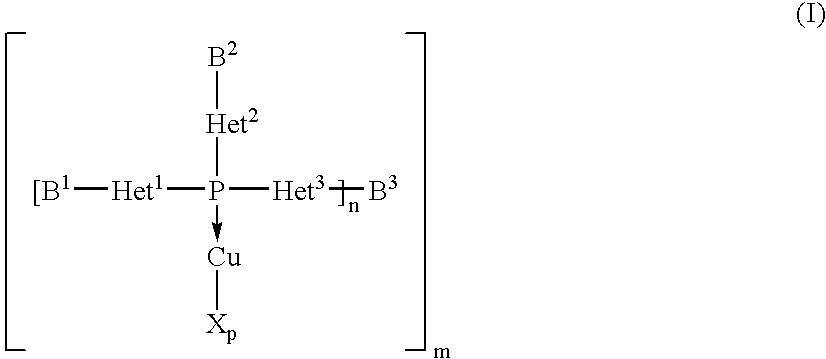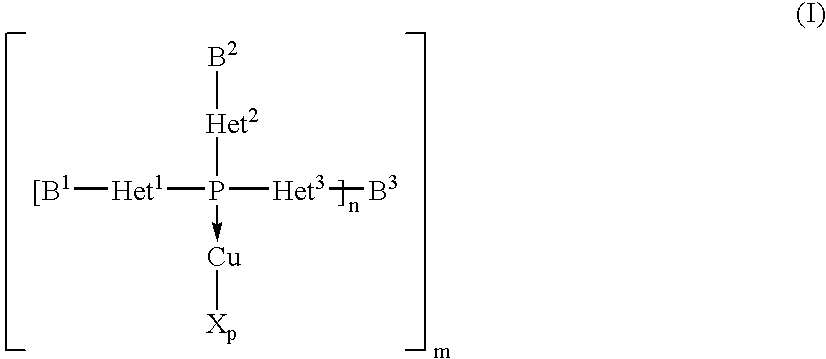Copper complexes and their use
a technology of copper complexes and complexes, applied in the field of copper complexes of phosphorus compounds, can solve the problems of low chemoselectivity and achieve the effect of high efficiency and easy preparation of compounds
- Summary
- Abstract
- Description
- Claims
- Application Information
AI Technical Summary
Benefits of technology
Problems solved by technology
Method used
Image
Examples
example 1
Preparation of bis(2-(di-tert-butylphosphino)biphenylcopper(I) bromide)
[0099]50 ml of degassed, anhydrous methanol were heated to reflux temperature, and 2.36 g (7.9 mmol) of 2-(di-tert-butylphosphino)biphenyl were added slowly to the methanol until the phosphine compound was completely dissolved. Subsequently, 0.59 g (2.6 mmol) of copper(II) bromide was added to the solution in portions. After the copper bromide had been added, the solution was heated to reflux temperature for a further 15 min, and then the solution was cooled. After the solution had been cooled, a solid precipitated out and was filtered off, and was washed with a little ethanol and diethyl ether and subsequently dried. 0.93 g (1.1 mmol) of the abovementioned compound was obtained. The yield was 80% of theory.
example 2
Preparation of bis(N-[2′-(dicyclohexylphosphino)-1,1′-biphenyl-2-yl]-N,N-dimethylaminecopper(I) bromide) dimer
[0100]50 ml of degassed, anhydrous methanol were heated to reflux temperature, and 2.00 g (5.1 mmol) of N-[2′-(dicyclohexylphosphino)-1,1′-biphenyl-2-yl]-N,N-dimethylamine were added slowly to the methanol until the phosphine compound was completely dissolved. Subsequently, 0.8 g (3.7 mmol) of copper(II) bromide was added to the solution in portions. After the copper bromide had been added, the solution was heated to reflux temperature for a further 15 min, and then the solution was cooled. After the solution had been cooled, a solid precipitated out and was filtered off, and was washed with a little ethanol and diethyl ether and subsequently dried. 1.5 g (1.4 mmol, M=1073.8 g / mol) of the abovementioned compound were obtained. The structure was checked by an FD-MS analysis (m / e=1074). The yield was 73% of theory.
example 3
Preparation of (3-[(diphenylphosphino)oxy]phenyl diphenyl phosphonite)copper(I) chloride
[0101]In a round-bottomed flask, 5 g (10.4 mmol) of 3-[(diphenylphosphino)oxy]phenyl diphenyl phosphonite are dissolved in degassed, anhydrous dichloromethane and heated to 40° C. 0.35 g of copper(I) chloride (0.35 mmol) is added. After 30 minutes of stirring, the solvent is removed under reduced pressure. The above-mentioned compound was obtained.
PUM
| Property | Measurement | Unit |
|---|---|---|
| temperatures | aaaaa | aaaaa |
| temperatures | aaaaa | aaaaa |
| areas of preference | aaaaa | aaaaa |
Abstract
Description
Claims
Application Information
 Login to View More
Login to View More - R&D
- Intellectual Property
- Life Sciences
- Materials
- Tech Scout
- Unparalleled Data Quality
- Higher Quality Content
- 60% Fewer Hallucinations
Browse by: Latest US Patents, China's latest patents, Technical Efficacy Thesaurus, Application Domain, Technology Topic, Popular Technical Reports.
© 2025 PatSnap. All rights reserved.Legal|Privacy policy|Modern Slavery Act Transparency Statement|Sitemap|About US| Contact US: help@patsnap.com



